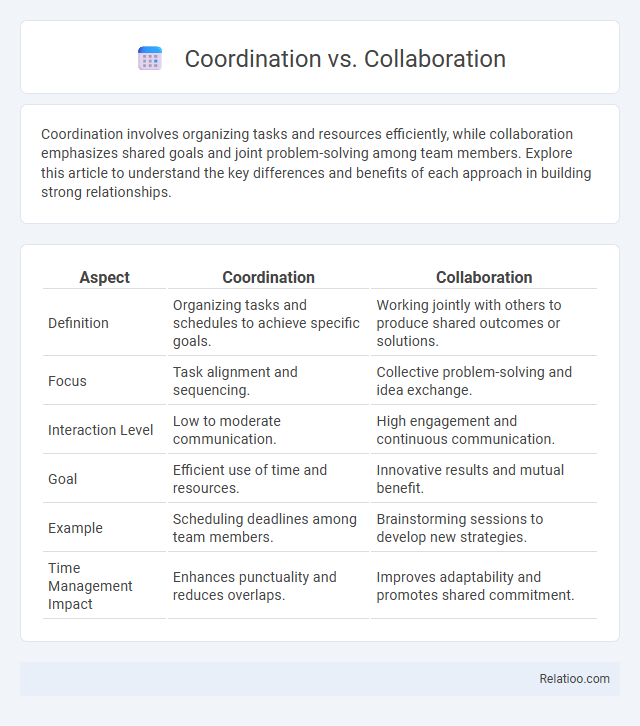Coordination involves organizing tasks and resources efficiently, while collaboration emphasizes shared goals and joint problem-solving among team members. Explore this article to understand the key differences and benefits of each approach in building strong relationships.
Table of Comparison
| Aspect | Coordination | Collaboration |
|---|---|---|
| Definition | Organizing tasks and schedules to achieve specific goals. | Working jointly with others to produce shared outcomes or solutions. |
| Focus | Task alignment and sequencing. | Collective problem-solving and idea exchange. |
| Interaction Level | Low to moderate communication. | High engagement and continuous communication. |
| Goal | Efficient use of time and resources. | Innovative results and mutual benefit. |
| Example | Scheduling deadlines among team members. | Brainstorming sessions to develop new strategies. |
| Time Management Impact | Enhances punctuality and reduces overlaps. | Improves adaptability and promotes shared commitment. |
Defining Coordination and Collaboration
Coordination involves organizing tasks and resources efficiently to achieve a shared objective, ensuring that everyone's efforts are aligned without duplication of work. Collaboration goes deeper by fostering active engagement and shared decision-making among team members, enhancing creativity and problem-solving through joint contributions. Your ability to distinguish between coordination and collaboration improves teamwork dynamics and drives project success.
Key Differences Between Coordination and Collaboration
Coordination involves organizing tasks among team members to achieve specific goals with clear roles and responsibilities, while collaboration emphasizes shared goals, active communication, and joint problem-solving, fostering innovation and creativity. Coordination focuses on efficiency and task completion through structured processes, whereas collaboration relies on collective input and mutual understanding to generate synergistic outcomes. Clear distinction lies in coordination's task-oriented approach contrasted with collaboration's relationship-driven dynamic.
The Importance of Coordination in Teams
Coordination in teams ensures that tasks are aligned and resources are efficiently utilized, minimizing overlaps and preventing delays. While collaboration emphasizes joint problem-solving and coordination focuses on organizing activities, proper coordination drives seamless workflow and clear communication in your team. Effective coordination fosters accountability and boosts overall productivity, making it essential for successful project execution.
The Role of Collaboration in Achieving Success
Collaboration plays a crucial role in achieving success by fostering shared goals, open communication, and mutual accountability among team members. Unlike coordination, which involves organizing tasks and aligning schedules, collaboration encourages active participation and idea exchange to drive innovation and problem-solving. Your ability to leverage collaboration can transform individual efforts into collective outcomes that significantly enhance project performance and organizational growth.
Benefits of Coordination in Project Management
Coordination in project management ensures the efficient alignment of tasks, resources, and team efforts, reducing redundancy and preventing conflicts. It enhances communication flow and accountability, leading to timely delivery and optimized use of resources. Effective coordination fosters a clear understanding of roles and responsibilities, improving overall project performance and stakeholder satisfaction.
Advantages of Collaboration for Innovation
Collaboration fosters diverse perspectives and skill sets, driving innovation through collective creativity and problem-solving. Your team benefits from seamless communication and shared goals, accelerating the development of novel ideas and solutions. Unlike simple coordination, collaboration cultivates a dynamic exchange that enhances adaptability and breakthrough innovations.
Challenges in Coordinating Teams
Challenges in coordinating teams often arise from misaligned goals, unclear roles, and communication gaps that hinder effective task management. Unlike collaboration, which emphasizes joint problem-solving and shared responsibilities, coordination requires precise synchronization of activities and resources to avoid overlaps or delays. Your team may struggle with varying priorities and decentralized information, making consistent coordination a critical focus for achieving operational efficiency.
Overcoming Barriers to Effective Collaboration
Effective collaboration overcomes common barriers such as communication breakdowns, lack of trust, and misaligned goals by fostering transparent dialogue and building mutual respect among team members. Implementing structured coordination mechanisms, like shared digital platforms and clearly defined roles, enhances accountability and real-time information flow that supports collective decision-making. Establishing consistent feedback loops and conflict resolution strategies ensures that collaboration remains dynamic, adaptive, and focused on achieving shared objectives efficiently.
When to Use Coordination vs Collaboration
Coordination is best used when tasks are interdependent but require clear roles and schedules to ensure efficiency, such as in project management with defined deliverables and timelines. Collaboration suits complex problem-solving scenarios demanding shared goals, diverse expertise, and collective decision-making, commonly seen in innovation teams or research groups. Understanding when to use coordination or collaboration depends on the need for either structured task alignment or dynamic interaction for creative outcomes.
Building a Culture of Coordination and Collaboration
Building a culture of coordination and collaboration requires aligning your team's goals and communication channels to enhance efficiency and innovation. Coordination ensures tasks are organized and resources allocated effectively, while collaboration fosters shared problem-solving and collective creativity. Emphasizing both creates a dynamic environment where your team can seamlessly work together to achieve common objectives.

Infographic: Coordination vs Collaboration
 relatioo.com
relatioo.com